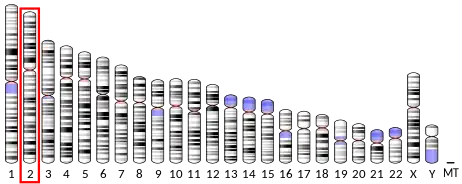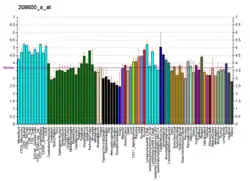| GPR39 | |||||||||||||||||||||||||||||||||||||||||||||||||||
|---|---|---|---|---|---|---|---|---|---|---|---|---|---|---|---|---|---|---|---|---|---|---|---|---|---|---|---|---|---|---|---|---|---|---|---|---|---|---|---|---|---|---|---|---|---|---|---|---|---|---|---|
| Identifiers | |||||||||||||||||||||||||||||||||||||||||||||||||||
| Aliases | GPR39, G protein-coupled receptor 39 | ||||||||||||||||||||||||||||||||||||||||||||||||||
| External IDs | OMIM: 602886 MGI: 1918361 HomoloGene: 20380 GeneCards: GPR39 | ||||||||||||||||||||||||||||||||||||||||||||||||||
| |||||||||||||||||||||||||||||||||||||||||||||||||||
| |||||||||||||||||||||||||||||||||||||||||||||||||||
| |||||||||||||||||||||||||||||||||||||||||||||||||||
| |||||||||||||||||||||||||||||||||||||||||||||||||||
| |||||||||||||||||||||||||||||||||||||||||||||||||||
| Wikidata | |||||||||||||||||||||||||||||||||||||||||||||||||||
| |||||||||||||||||||||||||||||||||||||||||||||||||||
G-protein coupled receptor 39 is a protein that in humans is encoded by the GPR39 gene.[5][6]
References
- 1 2 3 GRCh38: Ensembl release 89: ENSG00000183840 - Ensembl, May 2017
- 1 2 3 GRCm38: Ensembl release 89: ENSMUSG00000026343 - Ensembl, May 2017
- ↑ "Human PubMed Reference:". National Center for Biotechnology Information, U.S. National Library of Medicine.
- ↑ "Mouse PubMed Reference:". National Center for Biotechnology Information, U.S. National Library of Medicine.
- ↑ McKee KK, Tan CP, Palyha OC, Liu J, Feighner SD, Hreniuk DL, Smith RG, Howard AD, Van der Ploeg LH (Mar 1998). "Cloning and characterization of two human G protein-coupled receptor genes (GPR38 and GPR39) related to the growth hormone secretagogue and neurotensin receptors". Genomics. 46 (3): 426–34. doi:10.1006/geno.1997.5069. PMID 9441746.
- ↑ "Entrez Gene: GPR39 G protein-coupled receptor 39".
Further reading
- Popovics P, Stewart AJ (2011). "GPR39: A Zn2+-activated G protein-coupled receptor that regulates pancreatic, gastrointestinal and neuronal functions". Cell. Mol. Life Sci. 68 (1): 85–95. doi:10.1007/s00018-010-0517-1. PMID 20812023. S2CID 20170402.
- Bonaldo MF, Lennon G, Soares MB (1997). "Normalization and subtraction: two approaches to facilitate gene discovery". Genome Res. 6 (9): 791–806. doi:10.1101/gr.6.9.791. PMID 8889548.
- Strausberg RL, Feingold EA, Grouse LH, et al. (2003). "Generation and initial analysis of more than 15,000 full-length human and mouse cDNA sequences". Proc. Natl. Acad. Sci. U.S.A. 99 (26): 16899–903. Bibcode:2002PNAS...9916899M. doi:10.1073/pnas.242603899. PMC 139241. PMID 12477932.
- Ota T, Suzuki Y, Nishikawa T, et al. (2004). "Complete sequencing and characterization of 21,243 full-length human cDNAs". Nat. Genet. 36 (1): 40–5. doi:10.1038/ng1285. PMID 14702039.
- Holst B, Holliday ND, Bach A, et al. (2005). "Common structural basis for constitutive activity of the ghrelin receptor family". J. Biol. Chem. 279 (51): 53806–17. doi:10.1074/jbc.M407676200. PMID 15383539.
- Gerhard DS, Wagner L, Feingold EA, et al. (2004). "The Status, Quality, and Expansion of the NIH Full-Length cDNA Project: The Mammalian Gene Collection (MGC)". Genome Res. 14 (10B): 2121–7. doi:10.1101/gr.2596504. PMC 528928. PMID 15489334.
- Hillier LW, Graves TA, Fulton RS, et al. (2005). "Generation and annotation of the DNA sequences of human chromosomes 2 and 4". Nature. 434 (7034): 724–31. Bibcode:2005Natur.434..724H. doi:10.1038/nature03466. PMID 15815621.
- Kimura K, Wakamatsu A, Suzuki Y, et al. (2006). "Diversification of transcriptional modulation: Large-scale identification and characterization of putative alternative promoters of human genes". Genome Res. 16 (1): 55–65. doi:10.1101/gr.4039406. PMC 1356129. PMID 16344560.
- Holst B, Egerod KL, Schild E, et al. (2007). "GPR39 signaling is stimulated by zinc ions but not by obestatin". Endocrinology. 148 (1): 13–20. doi:10.1210/en.2006-0933. PMID 16959833.
- Lauwers E, Landuyt B, Arckens L, et al. (2006). "Obestatin does not activate orphan G protein-coupled receptor GPR39". Biochem. Biophys. Res. Commun. 351 (1): 21–5. doi:10.1016/j.bbrc.2006.09.141. PMID 17054911.
- Egerod KL, Holst B, Petersen PS, et al. (2007). "GPR39 splice variants versus antisense gene LYPD1: expression and regulation in gastrointestinal tract, endocrine pancreas, liver, and white adipose tissue". Mol. Endocrinol. 21 (7): 1685–98. doi:10.1210/me.2007-0055. PMID 17488974.
- Yasuda S, Miyazaki T, Munechika K, et al. (2007). "Isolation of Zn2+ as an endogenous agonist of GPR39 from fetal bovine serum". J. Recept. Signal Transduct. Res. 27 (4): 235–46. doi:10.1080/10799890701506147. PMID 17885920. S2CID 33411716.
This article is issued from Wikipedia. The text is licensed under Creative Commons - Attribution - Sharealike. Additional terms may apply for the media files.




